Related Research Articles

The fungal order Agaricales, also known as gilled mushrooms or euagarics, contains some of the most familiar types of mushrooms. The order has 33 extant families, 413 genera, and over 13,000 described species, along with six extinct genera known only from the fossil record. They range from the ubiquitous common mushroom to the deadly destroying angel and the hallucinogenic fly agaric to the bioluminescent jack-o-lantern mushroom.
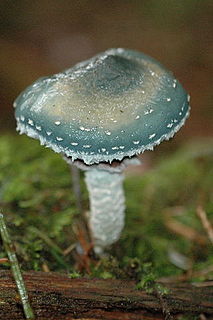
The Strophariaceae are a family of fungi in the order Agaricales. Under an older classification, the family covered 18 genera and 1316 species. The species of Strophariaceae have red-brown to dark brown spore prints, while the spores themselves are smooth and have an apical germ pore. These agarics are also characterized by having a cutis-type pileipellis. Ecologically, all species in this group are saprotrophs, growing on various kinds of decaying organic matter. The family was circumscribed in 1946 by mycologists Rolf Singer and Alexander H. Smith.

The Tricholomataceae are a large family of mushrooms within the Agaricales. Originally a classic "wastebasket taxon", the family included any white-, yellow-, or pink-spored genera in the Agaricales not already classified as belonging to e.g. the Amanitaceae, Lepiotaceae, Hygrophoraceae, Pluteaceae, or Entolomataceae.

The Hymenogastraceae are a family of fungi in the order Agaricales with both agaric and false-truffle shaped fruitbodies. Formerly, prior to molecular analyses, the family was restricted to the false-truffle genera. The mushroom genus Psilocybe in the Hymenogastraceae is now restricted to the hallucinogenic species while nonhallucinogenic former species are largely in the genus Deconica classified in the Strophariaceae.
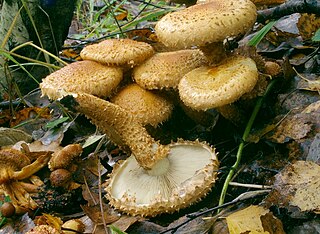
Pholiota is a genus of small to medium-sized, fleshy mushrooms in the family Strophariaceae. They are saprobes that typically live on wood. The genus has a widespread distribution, especially in temperate regions, and contains about 150 species.
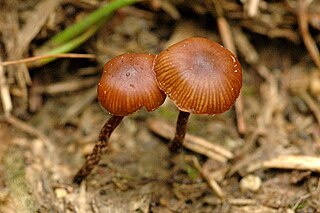
Deconica montana, commonly known as the mountain moss Psilocybe, is a common species of mushroom that is usually found growing in mossy areas, often in montane regions around the world. The appearance is that of a typical "little brown mushroom"—with a small, brown cap and a straight, thin stipe, growing separately or in clumps with others.

The Physalacriaceae are a family of fungi in the order Agaricales. Species in the family have a widespread distribution, ranging from the Arctic, (Rhizomarasmius), to the tropics, e.g. Gloiocephala, and from marine sites (Mycaureola) and fresh waters (Gloiocephala) to semiarid forests (Xerula).

The Inocybaceae are a family of fungi in the order Agaricales. Members of this family have a widespread distribution in tropical and temperate areas.
Arthromyces is a genus of fungi in the Lyophyllaceae family. The genus contain two species found in Central America.

Ossicaulis is a ditypic genus of mushrooms in the family Lyophyllaceae.
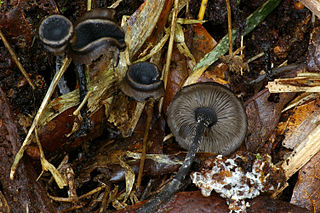
Blastosporella is a fungal genus in the family Lyophyllaceae. The genus is monotypic, containing the single South American species Blastosporella zonata, described as new to science in 2007. The fungus produces fruit bodies characterized by producing spherical balls of blastospores that cover the cap surface in maturity.
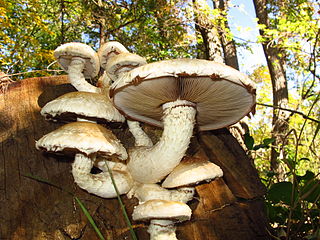
Hemipholiota is a genus of agaric fungi in the order Agaricales. It was originally proposed by Rolf Singer in 1962 as a subgenus of Pholiota to contain species with absent or sparse pleurocystidia and absent chrysocystidia. Henri Romagnesi raised it to generic status in 1980, but this naming was invalid as it did not meet the requirements of the International Code of Nomenclature for algae, fungi, and plants. Marcel Bon published the genus validly in 1986.

Nivatogastrium is a genus of secotioid fungi in the family Strophariaceae. The genus has contained four species found in North America and New Zealand, but the type species is now considered to be a gasteroid species of Pholiota, and was transferred to that genus in 2014.

Aphroditeola is an agaric fungal genus that produces pink cantharelloid fruit bodies on coniferous forest floors. The lamellae are forked and typically the fruit bodies have a fragrant odor described as candy-like, cinnamony or pink bubble gum-like. In the last century it was classified in Hygrophoropsis, a genus in the Boletales. However, Hygrophoropsis has dextrinoid basidiospores while Aphroditeola lacks these. Phylogenetically Aphroditeola is classified in the Agaricales near the Hygrophoraceae. Little is known about its biology except that the type species can be grown in culture from basidiospores and it produces pinkish to reddish-orange mycelium. In other literature and web sites the type species is called by synonymous names Hygrophoropsis morganii or Hygrophoropsis olida or incorrectly labelled Hygrophoropsis rufescens, a misapplied name.
Flammula is a dark brown-spored genus of mushrooms that cause a decay of trees, on whose bases they often fruit, forming clusters of yellowish brown mushrooms.

Meottomyces is a small genus of relatively nondescript, fleshy, brown mushrooms related to Tubaria. In older classifications it had been included in Pholiota, Phaeogalera or Hemipholiota. Modern molecular evidence suggested recognition of a separate genus when sequences of a collection first identified as Pholiota oedipus, now reclassified in Meottomyces, revealed a unique branch. Subsequently, that species was studied by Holec and later as Phaeogalera oedipus was shown to be distinct from Tubaria but not the type of Phaeogalera itself. Additional phylogenetic support was provided by Gitte Petersen and others, who clearly showed a separation from Phaeogalera. The genus was erected by Vizzini for two species and two varieties, all former members of Pholiota. Vizzini treated the name Pholiota oedipus as a misapplied name, but this is contested by Legon who provided detailed notes on the types and ecology of the type species.
Sphagnurus is a parasitic mushroom genus in the family Lyophyllaceae that creates conspicuous dead patches on peat moss (Sphagnum) in bogs. The genus contains one species known to inhabit Eurasia and North America. Phylogenetically the genus is closest to, but is isolated from species now classified in the genus Sagaranella Prior to molecular analyses, the most recent classification put it in the genus Tephrocybe, but that genus is allied to Termitomyces.
Myochromella is a mushroom genus in the family Lyophyllaceae that has been segregated from both Lyophyllum and Tephrocybe using molecular analyses and was first informally labelled clade 'mycochromella' or section 'Tephrophana p.p.' before being recognized as a genus. The species resemble grey colored Collybias and grow in forests.

The genus Saproamanita contains about 24 species of agarics and is one of six genera in the family Amanitaceae. The others are Amanita, Catatrama, Limacellopsis, Zhuliangomyces and Limacella. Saproamanita are the saprophytic species in the Tribe Amaniteae, separately classified from the ectomycorrhizal species in the genus Amanita.
References
- 1 2 3 Hofstetter, Valérie; Redhead, Scott Alan; Kauff, Frank; Moncalvo, Jean-Marc; Matheny, Patrick Brandon; Vilgalys, Rytas (2014). "Taxonomic revision and examination of ecological transitions of the Lyophyllaceae (Basidiomycota, Agaricales) based on a multigene phylogeny" (PDF). Cryptogamie, Mycologie. 35 (4): 399–425. doi:10.7872/crym.v35.iss4.2014.399. S2CID 84983803.
- ↑ Bellanger, J.-M.; Moreau, P.-A.; Corriol, G.; Bidaud, A.; Chalange, R.; Dudova, Z.; Richard, F. (2015). "Plunging hands into the mushroom jar: a phylogenetic framework for Lyophyllaceae (Agaricales, Basidiomycota)". Genetica. 143 (2): 169–94. doi:10.1007/s10709-015-9823-8. PMID 25652231. S2CID 15318615.
- ↑ Sagara N. (1973). "Proteophilous fungi and fireplace fungi (A preliminary report)". Trans. Mycol. Soc. Japan. 14: 41–46.
- ↑ Sagara N. (1975). "Ammonia fungi – a chemoecological grouping of terrestrial fungi". Contributions of the Biology Lab of Kyoto. 24: 205–76.
- ↑ Yamanaka, T.; Sagara N. (1990). "Development of basidia and basidiospores from slide-cultured mycelia in Lyophyllum tylicolor (Agaricales)". Mycol. Res. 94 (6): 847–850. doi:10.1016/s0953-7562(09)81390-7.